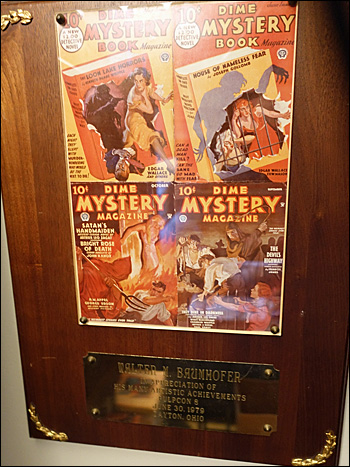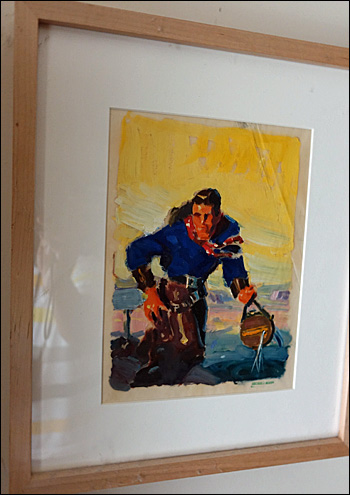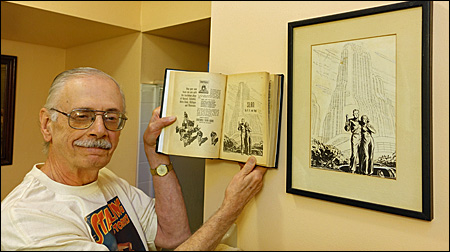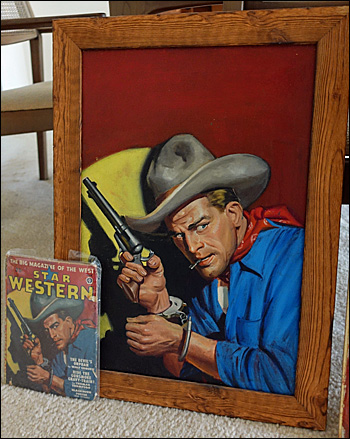COLLECTING PULPS: A Memoir
Part 20: Pulp Art, Part Two
by Walker Martin
This is a continuation of the pulp art subject which commenced in my last column numbered Part 19. When I started this column in 2010, I never planned for it to last and continue for long. I thought I’d just discuss my collecting of The Big Three in the detective genre(BLACK MASK, DIME DETECTIVE, DETECTIVE FICTION WEEKLY). But I’ve received such great support for the series that it has continued now to Part 20 and beyond.
And the Collecting Pulps subject led to me writing the series about ADVENTURES IN COLLECTING, and also book reviews and the pulp convention reports. I firmly believe we should be discussing these shows and collecting in general. I can remember the time when there was very little discussion of the importance and fun of collecting pulp magazines and original pulp art.
We all know about how much fun it is to read and collect these old magazines, but it also is of great importance. It will be difficult for future generations to be aware that once there was a golden period of excellent fiction magazines and illustration art. It’s hard now to even find a newsstand, but once there were thousands of such outlets in drugstores, deli grocery stores, and on street corners. The newsstands groaned under the weight of scores of fiction magazines both pulp and slick. And they all used illustrations from talented artists that numbered in the hundreds.
I collect this great art and the columns titled Part 19, Part 20, and Part 21 (upcoming) contain the story about how I managed to track down and find many unique cover paintings and interior illustrations. Every now and then the accusation is made that you have to be rich in order to collect paintings and sets of long running magazines. No, you don’t, and I’m living proof of how it can be done on a middle class income.
True, you have to be a committed and enthusiastic collector, but I built up this collection while working on a salary and bringing up a family with the usual mortgages, car payments, and other bills. I often went through periods where I had very little money in the bank account, or I had to borrow money from the credit union at work. For many years I skipped lunch in order to save money to buy books. Sounds familiar right? I’m sure many collectors have scrimped and saved in order to feed their collections. And yet they still had all the usual things that we take for granted such as family, children, homes, cars, education.
One of my favorite book conventions is Pulp Adventurecon, otherwise known as the Bordentown show, or Harveycon, after Rich Harvey the organizer of the show. He’s been putting it on for almost 20 years now, and it is an annual event held every November. Officially it’s a one day show, but for the last several years, I and some of my best friends have turned it into a four day convention lasting Wednesday, Thursday, Friday, and Saturday. Not only do we discuss books, pulps, and art, but we eat and drink everything in sight. It’s like a gigantic bookish picnic and party.
This photo shows several of us at my kitchen table: left to right is me in a SHORT STORIES T-shirt, Matt Moring, Digges La Touche, Scott Hartshorn, and Ed Hulse. Also present but not in the photo are Sai Shanker, who is responsible for these great photos, Nick Certo, Paul Herman, and Laurie Powers. These are all committed and serious collectors that I have known for many years.
And fitting in with the collecting art theme, they all collect art except for Ed. Even Ed has a big interest in the art and though Digges and Laurie only have a piece or two, they represent what I think every book and pulp collector should strive for, and that is to have at least one representative piece of art to go with your collection of books. Anthony Powell once titled a novel, BOOKS DO FURNISH A ROOM, and so does original art.
Two weeks prior to the show, Doug Ellis and Deb Fulton visited me and I finally managed to obtain an Edd Cartier illustration from one of my favorite magazines, UNKNOWN WORLDS. In a prior convention report I had bemoaned the fact that I had missed out on a previous Edd Cartier drawing from UNKNOWN. I think this 1941 drawing showing a scene from a Jane Rice story is even better that the one I missed out on.
Before I move on to more art, I would like to mention that this year’s Pulp Adventurecon was one of the best yet. 50 tables and well over a hundred attendees. No guests, no panels, no movies. Just hard core pulp collecting and book buying! Two important items made their debut at the convention: ART OF THE PULPS, an excellent book on the pulps and the artwork, by Doug Ellis, Ed Hulse, and Bob Weinberg and the third issue of the new and revived BLACK MASK.
Matt Moring and I shared a table, and many collectors were wearing the Altus Press pulp T-shirts. These look great, and Matt has over a dozen titles available. The selection can be seen on the Altus Press website and so can the hundreds of pulp reprints that Altus Press has published.
Though this is only a one day show, there are many unusual and rare items for sale. A couple years ago I completed my set of ALL STORY at this convention, and you can’t get rarer that that. This year John Gunnison of Adventure House, had many bound volumes of FLYNN’S and DETECTIVE FICTION WEEKLY from the 1920’s and early 1930’s. Also available from Altus Press was a complete run of ASTOUNDING, 1937-1943 which are the great John Campbell years, otherwise known as The Golden Age of SF.
I had a couple stacks of the rare British mystery digest magazine, LONDON MYSTERY MAGAZINE. So there were some rare and collectible items. Speaking of rare items, I also saw and spoke with Bob Lesser, another pulp art collector. He says he is 94 years old! That give us all hope for the future and a reason to keep collecting even when we get old.
Matt Moring and I completed a pulp cover painting trade. Here Matt is holding a cover from SKY RIDERS, 1929, that he has just traded to me. Many pulp cover paintings and interior illustrations change hands through trades.
Another painting Matt traded to me: PEOPLES from 1922 and the artist is Franklin Wittmack.
This item is absolutely unique, and something I never thought I’d find. For decades, ever since Pulpcon started to give the Guests of Honor a plaque in honor of their work in the pulp field, I have wanted to find one of the plaques for my collection. It was the one thing that Pulpcon got absolutely right because these plaques are beautiful. I have seen many of the guests get emotional after receiving these great plaques. They always show four pulp covers and bear the guest’s name while praising them for their contributions to the pulps. This one I found out about when I read an article by David Saunders. Dan Zimmer, the publisher of ILLUSTRATION MAGAZINE, had it hanging in his office and I managed to buy it. It’s the one given to Walter Baumhofer during Pulpcon 8, 1979 in Dayton, Ohio.

This is from ADVENTURE in the 1940’s. During a visit to Gerry De Ree’s house in 1989, I saw two beautiful paintings by Earle Bergey from STARTLING STORIES. Gerry had a terminal illness and was selling his collection, but the price was more than I could pay for the two Bergey paintings. He saw how disappointed I was and sold me this painting at a special bargain price. Gerry was a great collector and dealer and has never been replaced.
This is a favorite of mine because of the unusual scene depicted. A sixgun preacher in a saloon forcing the boozers to listen to his sermon. I got it at an early Pulpcon for only a couple hundred dollars.
1930’s DETECTIVE FICTION WEEKLY by Rudolph Belarski. Author Richard Sale had two popular series characters, Daffy Dill and Candid Jones. This cover illustrated the story where they meet. Artists often had to leave space for writing on the the cover. This square was for the blurb “Daffy Dill and Candid Jones, Together Again!” Many collectors would not buy this art because of the empty yellow square but I love it. Plus it made it affordable for me to buy it!
The reason for this photo is sort of weird. If you look carefully you can see 6 small risque paintings by J. Brandt. They all are signed and were submitted in the paper envelope I’m holding to CASTLE OF FRANKENSTEIN magazine. But the publisher and editor, Calvin Beck, never used them as far as I know and never returned them to the artist.
Now J. Brandt paints fine art and would be amazed to see his teenage paintings have survived. I consider these paintings to be sort of outsider art and of great interest as examples of unique and strange pieces of art. Most collectors would bypass these as just unpublished amateur work, but I think they are beautiful.
DIME MYSTERY in the 1940’s. Many collectors have a fetish for guys or women in hoods! I love it!
Lee Brown Coye, one of my favorite artists, but many collectors are blind to his great bizarre talent. There have been three recent books discussing his work. This lacks the Coye weird figures but has the bizarre house and the sticks that became his trademark in later life.
Nick Eggenhofer is one of the greatest of the pulp artists and he did hundreds of illustrations for WESTERN STORY and the Popular Publication pulps. For many years I couldn’t find one of his illustrations that I could afford but finally in the 1980’s I found one and the floodgates have opened. I now have 9 or 10. One of the great books on the pulps is one titled EGGENHOFER: THE PULP YEARS.
I have over 30 of these smaller preliminary paintings and drawings like the one below, all framed by art dealer Steve Kennedy in the same type of frame. The artists were often requested to submit a preliminary sketch or painting before receiving the ok to do the finished cover painting. Many of these prelims are well done and some are mere sketches, very rough indeed. I have them in all styles, some painted like these but some drawn in pencil or ink. Most collectors do not seem to want to bother with these preliminary sketches but I like them a lot.

Here I am holding up the issue of ASTOUNDING which started the serial, SLAN by Van Vogt. I obtained the drawing back in the 1970’s at the Toronto world science fiction convention. I have a total of six Charles Schneenman drawings, all from ASTOUNDING in the 1940’s. I got them for the minimum bid at the big auction. No one else was interested in bidding! A puzzle that I cannot understand. One thing about collecting art is that you eventually run out of wall space. These six drawings are hung in the master bathroom. Not a good idea but I don’t want to add them to the ones I have stacked against the wall, unable to hang them for lack of space.

This is a painting that I just traded to Matt Moring. Richard Lillis is the artist for this cowboy portrait from STAR WESTERN. The Lillis is the last one I bought from Steve Kennedy before his early and sudden death two years ago. He had met Lillis at an art class and they became friends even though Steve was in his 30’s and Lillis in his 80’s. They became friends and when Lillis died in his 90’s, Steve was the executor of the estate. Prior to meeting Lillis Steve was mainly a fine art dealer and knew nothing about the pulps. This friendship changed Steve’s life because he started to specialize in pulp art.

De Soto didn’t sign many of his pulp paintings but this ADVENTURE cover is signed. Sometimes we forget that non-collectors just do not understand the collector. This is an example. I had this painting hanging in a good spot in the powder room but one year after returning from Pulpcon, my wife had moved it and replaced with a $20 Walmart decoration. I just don’t understand how non-collectors think.
Charles Dye cover for ADVENTURE. Bargains are still out there. I got this from Heritage Auctions and didn’t have to pay much at all.
This is an unfinished ADVENTURE cover and I guess we will never know the story behind it. It looks like it was painted in the teens which means it is a hundred years old. But why did the artist stop painting? Perhaps the editor did not like it? We will never know. And how on earth did it survive all these years. Even finished excellent paintings were often destroyed or lost.
STAR WESTERN by DeSoto and I’ve owned it twice, which is not an uncommon occurrence with me. I first had it many years ago and the previous owner got it back in a trade. Then a couple years ago I got it back again. Unusual scene.
This drawing by Lorence Bjorklund is representative of the ones I just bought from Paul Herman. One good side effort of the pulp brunches is that I often get art, pulps, books. These are quite interesting and were published as interiors in WILD WEST WEEKLY and WESTERN STORY.
This is the room where I write these columns, surrounded by art and books.
Close up of the three Lyman Anderson drawings from UNDERWORLD. These were among the first pieces of art that I bought back in the early 1970’s. Nils Hardin had a stack of them and I picked only three. Why only three? Maybe I was broke?
TO BE CONTINUED IN PART 21
